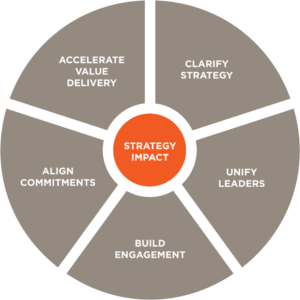-

From strategic intent to business impact – Five principles for successful strategy implementation
Read More » -

Getting the most out of natural gas
ETH scientists have discovered a new catalyst that allows the easy conversion of natural gas constituents into precursors for the production of fuels or complex chemicals, such as polymers or pharmaceuticals. The new catalyst is extremely stable and results in fewer unwanted by-products.
 The use of natural gas as a raw material for chemicals production is a goal pursued intensively in chemical research. Scientists working under Javier Pérez-Ramírez, Professor of Catalysis Engineering, have now succeeded in optimising a process which enables natural gas constituents to be upgraded into higher-value chemicals. “We take a molecule of the natural gas constituent methane (CH4) and replace one of its hydrogen atoms with a bromine atom to form methyl bromide (CH3Br),” explains Pérez-Ramírez. “The latter can be used as a base material in the chemical industry for the production of fuels and a range of chemicals, such as polymers and pharmaceuticals.”
The use of natural gas as a raw material for chemicals production is a goal pursued intensively in chemical research. Scientists working under Javier Pérez-Ramírez, Professor of Catalysis Engineering, have now succeeded in optimising a process which enables natural gas constituents to be upgraded into higher-value chemicals. “We take a molecule of the natural gas constituent methane (CH4) and replace one of its hydrogen atoms with a bromine atom to form methyl bromide (CH3Br),” explains Pérez-Ramírez. “The latter can be used as a base material in the chemical industry for the production of fuels and a range of chemicals, such as polymers and pharmaceuticals.”Complete bromine recycling
When methyl bromide is transformed into fuels and chemicals, bromine is released in the form of hydrogen bromide (HBr). “The beauty of our reaction is that it enables the bromine from hydrogen bromide to be embedded back into methyl bromide, using oxygen. In this way, the bromine cycle is closed, and no bromine is lost”, says Pérez-Ramírez.
The oxybromination of methane, as the reaction is called, can already be carried out today using catalysts (reaction accelerators). However, they typically generate large quantities of unwanted products. The ETH catalysis specialists therefore looked for a way to improve the reaction’s selectivity. In a multi-step selection process, they investigated a large number of different catalyst materials. Vanadium phosphate proved to be the most suitable.
More efficient than via syngas
Vanadium phosphate is a relatively mild oxidising catalyst, and this is exactly what chemists are seeking in the oxybromination of methane. On the one hand, the catalyst is sufficiently strong to allow hydrogen bromide to react with oxygen at the catalyst’s surface. On the other hand, the catalytic action of vanadium phosphate is too weak to oxidise the unwanted methane and the brominated reaction products.
 “Our method makes it possible to brominate methane in a single step at atmospheric pressure and at temperatures below 500 degrees Celsius. This makes it an attractive route for industry,” says Vladimir Paunović, a doctoral student in Pérez-Ramírez’s group. Currently, methane is industrially converted into higher grade chemicals using syngas as an intermediate. However, this method is extremely energy-intensive as it requires high pressures (up to 30 bar) and high temperatures (up to 1,000 degrees).
“Our method makes it possible to brominate methane in a single step at atmospheric pressure and at temperatures below 500 degrees Celsius. This makes it an attractive route for industry,” says Vladimir Paunović, a doctoral student in Pérez-Ramírez’s group. Currently, methane is industrially converted into higher grade chemicals using syngas as an intermediate. However, this method is extremely energy-intensive as it requires high pressures (up to 30 bar) and high temperatures (up to 1,000 degrees).Long catalyst lifetime
The new catalyst is exceptionally stable. “Bromine is a halogen. Halogens react very readily with methane, which is desirable in this case, but they also attack the catalyst,” explains Paunović. “Our catalyst resists the corrosive reaction environment, which is essential for its potential industrial application.”
The reason why chemical researchers are striving to make greater use of natural gas as a raw material for synthesis is primarily because it occurs in huge quantities. “We are currently experiencing a boom in natural gas exploration. If you include unconventional, hard to access reservoirs, such as shale gas or coal bed methane, estimates indicate that gas deposits will last for at least 100 years,” says Pérez-Ramírez. Today, the raw material typically used for chemical products is oil. Oil deposits are in decline, however, and chemists see natural gas as a suitable alternative.
Source: ETHZ News
Read More » -

SAFILO AND SWATCH ANNOUNCE FIVE-YEAR COLLABORATION AGREEMENT
 Italian eyewear creator Safilo and Swatch Ltd have signed a collaboration agreement for Swatch branded sunglass Eyewear. Creative, playful and lifestyle oriented, Swatch The Eyes will be launched in spring 2016. The launch of the collection will be supported by the “I ALWAYS WANT MORE LOOKS” Swatch advertising campaign – as fun, provocative and smile-inducing as ever!
Italian eyewear creator Safilo and Swatch Ltd have signed a collaboration agreement for Swatch branded sunglass Eyewear. Creative, playful and lifestyle oriented, Swatch The Eyes will be launched in spring 2016. The launch of the collection will be supported by the “I ALWAYS WANT MORE LOOKS” Swatch advertising campaign – as fun, provocative and smile-inducing as ever!Safilo and Swatch are to co-design eyewear collections and Safilo is to develop and manufacture the eyewear in its European production network.
 In line with the global brand commitment to high quality service to customers, Swatch The Eyes will be distributed through Swatch’s global retail network and initially in Safilo’s US retail chain, Solstice, followed by rigorously selected North American eyewear retailers. Swatch and Safilo intend to successively expand Safilo’s distribution to further regions across the world via an eyewear network of the highest standards, in addition to the Swatch Group’s own distribution network.
In line with the global brand commitment to high quality service to customers, Swatch The Eyes will be distributed through Swatch’s global retail network and initially in Safilo’s US retail chain, Solstice, followed by rigorously selected North American eyewear retailers. Swatch and Safilo intend to successively expand Safilo’s distribution to further regions across the world via an eyewear network of the highest standards, in addition to the Swatch Group’s own distribution network.Source: Swatch News
Read More »


 Below is only a selection of Implement Consulting Groups new viewpoints on change – you can download the article here.
Below is only a selection of Implement Consulting Groups new viewpoints on change – you can download the article here.




